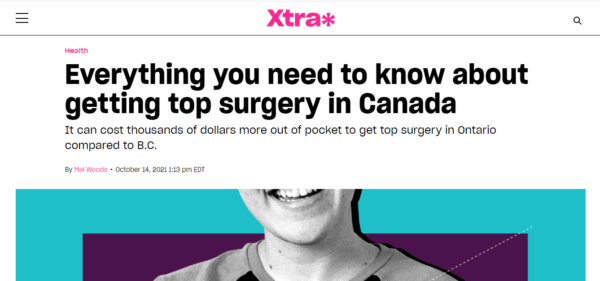It’s not great.
Journalist Mel Woods recent published an article with Xtra, “Everything you need to know about getting top surgery in Canada,” which looks at the disparities across Canada for trans people seeking top surgery.
I’m quoted in it about my recent experience trying to navigate Ontario’s opaque regulations and requirements and incomplete coverage with OHIP (the Ontario Health Insurance Plan). I was lucky to have a GP, though she wasn’t familiar with the process, and as with most things related to trans health, I had to do most of the legwork to get the process started. Many trans people don’t have a GP they trust, or even a GP at all.
It then required several interviews with a psychologist (for some reason?), a referral to OHIP, a referral to a surgeon, then waiting, waiting, waiting. Nearly $3,000 paid out of pocket to the clinic, because OHIP doesn’t cover contouring or what’s called chest “masculinization.” (My chest isn’t masculine. It’s genderqueer. Like the rest of me.) Another fee that can be prohibitive for trans people. (This is why so many trans people pass $50 between each other as they set up crowdfunding campaigns to undergo surgery.)
A surgery date was finally schedulled. Then cancelled, because: covid. Then more waiting, waiting. Another date scheduled with a different surgeon.
And then it finally happened at the beginning of July. Though, on my way into the operating room, the person administering the anesthesia misgendered me, which was more than a little alarming as I lost consciousness. But I came out of it grateful and happy to have it finally over with.
While the surgery was over, and I was eight pounds lighter, I still had the recovery to get through, which is at least four-to-six weeks of very little activity. Unfortunately, aftercare instructions were sparse and were restricted to what I could lift (less than 10 lbs) and when I could exercise (four weeks — but realistically, not even remotely possible). I was lucky enough to be able to take the time off and to have someone there who could support me during my recovery. (And it does seem like luck.)
There were no guidelines on when I could expect to regain range of motion with my arms (more than eight weeks), nor when the numbness would dissipate (still waiting for it to do so fully). Never mind stretching exercise, nipple care instructions, and so on.
Like most trans people, I had to rely on networks of other trans people who had previously undergone the surgery to find the healthcare information I needed. (Skylar Soopaiboon’s zine Basic [Top] Surgery Survival Guide – A Zine for Trans and Non-binary Babes and Allies was particularly helpful!) I’m still not fully recovered and my surgery didn’t come out quite the way it should, despite the extra money I paid.
Though the media occasionally takes an interest, stories like this aren’t new. ((Al Donato, “With health-care disparity rampant, trans people turn to each other for help,” Global News, 31 March 2021; Brooke Taylor, “Trans health care in Canada needs major improvements, advocates say,” CTV News, 22 May 2021.)) There have been studies. ((Rachel Giblon and Greta R. Bauer, “Health care availability, quality, and unmet need: A comparison of transgender and cisgender residents of Ontario, Canada,” BMC Health Services Research 17 (2017): 1-10.)) Books have been written. ((The Remedy: Queer and Trans Voices on Health and Health Care, edited by Zena Sharman (Vancouver: Arsenal Pulp Press, 2016).)) But little seems to change, and what does change, changes slowly.
When I was an undergraduate student I interned at the ArQuives (formerly the Canadian Lesbian and Gay Archives), and during my time there I put together an exhibition on their materials on what it meant to be nonbinary in Canada, titled, perhaps uncreatively, Genderqueer in Canada. ((Note: I have a strong aversion to the term “nonbinary.” I dislike being defined through negation, so I prefer the term “genderqueer.” Hence the title of the exhibition.)) For that project, my focus was on the numerous and wonderfully heterogenous array of terms used to describe what it meant to be the “other” or (sometimes) third gender in Canada, and on the slow progress for legal recognition (still incomplete).
Articles like Mel Woods’ — written by trans people, for trans people — are sorely needed, because beyond lamenting what isn’t present, they actually provide a list of resources by province, which can help someone find the care they need. Though, in all likelihood, they’ll also still need to rely on trans care networks. If that’s you right now, email me, and I’m available to chat.


